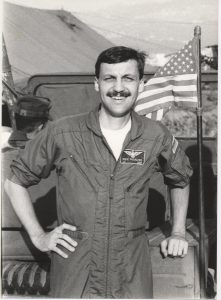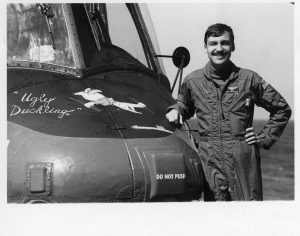CDR Michael N. Pocalyko, USN (Ret.)



Commander Pocalyko, a native of Bethlehem, Pennsylvania, entered the Aviation Reserve Officer Candidate (AVROC) program in May 1974 while an undergraduate at Muhlenberg College. He was commissioned Ensign USNR in December 1976 from Aviation Officer Candidate School at NAS Pensacola, then earned his Wings of Gold and designation as an unrestricted Naval Aviator at Helicopter Training Squadron EIGHTEEN (HT-18), NAS Whiting Field, in November 18,1977. ENS Pocalyko was Navy Helicopter Pilot Designation Number R-14465.
After Fleet Replacement Squadron training at Helicopter Anti-Submarine Squadron ONE (HS-1), NAS Jacksonville, he reported to Fleet Composite Squadron EIGHT (VC-8), NS Roosevelt Roads, Puerto Rico, where he flew the SH-3G Sea King from 1978 to 1981 and got his callsign “Polecat.” He joined the NHA at a “Rotorhead Rumble” at NAS North Island in 1979. At VC-8 he was HAC of the crew that flew Marines to the site of the ambush at NAVCOMMSTA Sabana Seca on December 3, 1979. The Cuban leftist-backed terrorist attack by Los Macheteros killed two Navy petty officers and gravely injured ten other sailors. On January 12, 1981 he flew into the Muñiz Air National Guard Base at Isla Verde, when Puerto Rican separatist terrorists broke through the perimeter fence and bombed nine Air National Guard A-7D Corsair IIs. During his nugget tour at VC-8 he augmented to the regular Navy and was awarded the Sikorsky “Winged S” and the Humanitarian Service Medal for helicopter rescues.
Following transition training to the SH-2F Seasprite at Helicopter Anti-Submarine Squadron (Light) THIRTY (HSL-30), Commander Pocalyko joined Helicopter Anti-Submarine Squadron (Light) THIRTY-FOUR (HSL-34) at NAS Norfolk. From HSL-34 he deployed in LAMPS detachments embarked on USS Peterson (DD-969) during OCEAN VENTURE 1981 in the North Atlantic; on USS Briscoe (DD-977) in the Mediterranean and Persian Gulf during the Iran-Iraq War (1981-1982); and in 1983 on USS Pharris (FF-1094) as a unit of the Multi-National Force in Beirut, Lebanon. At 0622 hours on October 23, 1983, he was pilot in command of the only aircraft airborne in theater at the moment of the Beirut Marine barracks bombing that claimed the lives of 241 American service members—220 Marines, 18 sailors, and 3 Army soldiers. In 1984 he deployed again on USS Pharris as OINC of HSL-34 Det 4 for anti-submarine warfare operations countering the Soviet “Analogous Response” sortie of Yankee- and Delta-class SSBNs to the North Atlantic. In HSL-34 he received the Kaman “K” Rescue Award.
With Navy sponsorship Commander Pocalyko earned his Master in Public Administration (MPA) degree from Harvard University’s John F. Kennedy School of Government in June 1985.
In the Pentagon from 1985 to 1987 he was a member of the OPNAV Strategic Concepts Group (OP-603) as desk officer for the Navy’s “Forward Maritime Strategy,” and Special Assistant to the Deputy Chief of Naval Operations for Plans, Policy and Operations (OP-06X). He was designated a Joint Specialty Officer and a proven subspecialist in politico-military affairs.
In 1987 Commander Pocalyko transitioned to his third Fleet helicopter, the SH-60B LAMPS Mk III, in Helicopter Anti-Submarine Squadron (Light) FORTY (HSL-40) at NS Mayport. He was a Plankowner in Helicopter Anti-Submarine Squadron (Light) FORTY-SIX (HSL-46) in 1988 and deployed in USS Boone (FFG-28) as OINC of HSL-46 Det 3 to the Mediterranean and Persian Gulf. During Operation EARNEST WILL in 1989 he escorted oil tankers and engaged in special operations as commander of a CTF-158 element in MIDEASTFOR, with the addition of US Army aviation crews of armed OH-6A Cayuse light observation helicopters to his detachment. On Boone he was additional qualification designated as a Surface Warfare Officer. During his tour at HSL-46 he was also NHA’s national Vice President.
From1990 to 1992 he served in the Office of Program Appraisal, which was then the Secretary of the Navy’s small staff. He was the Secretary’s action officer for national security strategy and had adjunct responsibilities for helicopter aviation matters.
In 1992-1993 he was a Federal Executive Fellow and resident Senior Fellow at The Atlantic Council in Washington, worked in Russia and Ukraine, and was a US delegate to the Eurogroup.
From 1993 to 1995 Commander Pocalyko was Military Assistant to the Director and Chief of Staff of the Defense Technology Security Administration (DTSA) in the Office of the Secretary of Defense. While at DTSA he earned his Master of Business Administration (MBA) degree from the Wharton School of the University of Pennsylvania in May 1995 and retired from active duty on September 1, 1995.
His 21 service awards include the Meritorious Service Medal (three awards), the Navy Commendation Medal, Navy Achievement Medal, Armed Forces Expeditionary Medal (two awards), Navy Expeditionary Medal, and various unit awards and service ribbons. He is authorized to wear the Office of the Secretary of Defense Identification Badge.
In his career as a Navy helicopter pilot, Commander Pocalyko flew 3,247 flight hours and made 1,139 small-deck landings.
He has been married since 1976 to Barbara Snelbaker Pocalyko, daughter of Commander James K. Snelbaker CHC USN (1922-1992), who was the commissioning chaplain of the Naval Aviation Memorial Chapel at NAS Pensacola in 1961. Mike and Barbara have homes in northern Virginia and the Shenandoah Valley. They have a son and daughter and three grandchildren.
After naval service, Commander Pocalyko became an investment banker, corporate director, CEO, novelist, and President of the Cosmos Club.
